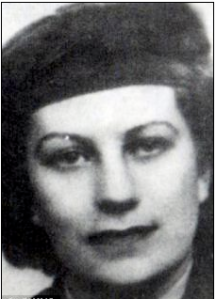It was my initial idea to precede a commentary on Sarah Water’s remarkable novel The Night Watch with a true story of a WW2 hero, because
the post war life of Water’s character Kay connects in my mind with this true story, but I subsequently decided I could not properly begin an article or an essay or indeed any piece of writing with a digression. Instead, I decided this post could stand on its own merits, to be followed later by another on The Night Watch.
This post is about the life of a remarkable woman. Her name was Eileen Nearne.
I obtained the digital facsimiles of her S.O.E Finishing Report and other documents shown here from The British National Archives.
This story, like The Night Watch, began in a backwards chronological direction when the neighbors of an 89 year old woman who had been living in a flat in Torquay became concerned about her welfare and alerted the authorities on September 15th 2010.
The woman, Eileen Nearne, was found dead the same day, though her body was supposed to have remained undiscovered for an unspecified length of time before that, perhaps as long as two weeks. The cause of death was determined to be ‘natural causes’ – the particular cause which precipitated the fatality being deemed ‘a heart attack’.
Nearne had never married, and she had no friends or family. She had lived in her Torquay flat for two decades, during which time she had been intractably reclusive. When the occasion arose of disposing of her remains, the authorities found that they had to 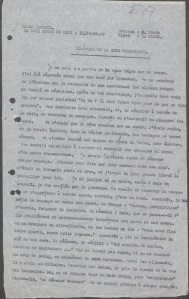 step in, because Nearne had no living relatives, and therefore no one who could be found to foot the cost of a funeral.
step in, because Nearne had no living relatives, and therefore no one who could be found to foot the cost of a funeral.
I suppose it was in the course of this pecuniarily inspired investigation that the facts about Nearne’s remarkable past were uncovered.
When council workers found obsolete French currency, old correspondence and military medals among her effects, it was determined that Nearne was a decorated war hero, who had served her country as a radio operator the U.K. Special Operations Executive during WW2, in occupied France. In 1944, at the perilously tender age of 23, the fluently bilingual Nearne had worked as a wireless operator under the nom de guerre of Mademoiselle du Tort, and the code name ‘Rose’. She also used the names of Jacqueline Duterte (coincidentally her older sister’s name was Jacqueline) and ‘Alice Wood.’
The S.O.E parachute-dropped Nearne behind enemy lines in France on March 2nd 1944. Soon thereafter she was captured by the Gestapo, but managed to convince them she was an ordinary shop-girl. She was found out and arrested again four months later, on August 15th 1944, when her transmitter was detected by the Gestapo. The Gestapo then tortured Nearne in order to extract information about her mission.
A report made by the BBC after Nearne’s death states that she “survived in silence the full revolting treatment of the baignoire” (probably a practice that resembles what we know of today as ‘water-boarding’) in the torture chambers of the Gestapo on the Rue des Saussaies.
practice that resembles what we know of today as ‘water-boarding’) in the torture chambers of the Gestapo on the Rue des Saussaies.
Nearne was then sent to Ravensbrück concentration camp and from there to a forced-labour camp in Silesia where she was again tortured. Here her head was shaved, and she was threatened with shooting for refusal to follow work orders. The sheer beastliness of the Germans has been extensively documented in innumerable other instances, but suffice it to say that camp life was barely survivable. The prisoners were forcibly subjected to 12 hour work-days on a diet of acorn coffee, turnip soup, and a little dried bread, and were expected to work until they died of exhaustion.
On April 13th 1945, Nearne, while on a forced night march from Ravensbrück, managed to escape with two other French girls who were her fellow prisoners and members of a camp work gang. The trio hid in the forest, and made it all the way to Leipzig, a distance of 213 km, before being arrested by the S.S. Once again, Nearne, an accomplished linguist, managed to talk herself and her fellow escapees out of potentially deadly situation by convincing the Germans that she and her friends were ordinary Frenchwomen who had lost their papers. They managed to reach Leipzig where a priest hid the unconscious Nearne in a bell tower until the Germans had been defeated.
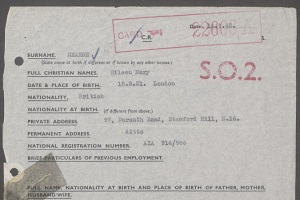 Nearne (described by some as Anglo-Spanish but elsewhere as the youngest of four children of an English father and French mother),moved to France in 1923 when she was two years old, and this might explain how her British origins came to be nearly undetectable.
Nearne (described by some as Anglo-Spanish but elsewhere as the youngest of four children of an English father and French mother),moved to France in 1923 when she was two years old, and this might explain how her British origins came to be nearly undetectable.
Nearne and her family fled through Spain in 1942 on the way back to England two years after the war in France began. Her two older siblings, her sister Jacqueline who was the oldest and her brother Francis, were also S.O.E operatives. There was another brother Frederick, about whom nothing is known.
After the war was over the Nearne sisters (there is no further mention of Francis) returned to England by way of Portugal and Gibraltar. It is an irony that Nearne was at first ‘identified’ by American Intelligence as a Nazi Collaborator! An American interrogator stated “Subject creates a very unbalanced impression. She often is unable to answer the simplest questions, as though she was impersonating someone else. Her account of what happened to her after her landing in Orleans is held to be invented. It is recommended that Subject be put at the disposal of the British Authourities for further investigation and disposition.” But doubts were set aside when London confirmed Nearne’s statements.
confirmed Nearne’s statements.
Nearne was awarded an M.B.E on the14th of February 1946 by George VI for ‘services in France during the enemy occupation.’ The sisters lived in London until Jacqueline’s death in 1982. Eileen moved to Torquay in 1990. She had been devastated by the death of her sister, and was said to have ‘suffered psychological problems resulting from her wartime service’ – but more properly as a result of being tortured by the Germans.
What are we to make of this amazing story? Nearne’s heroic past was discovered only because among her possessions were found several medals (one of them the French Croix de Guerre with Palm which was awarded to her on the 16th of January 1946), old devalued French currency and some French correspondence. There was talk of the medals being 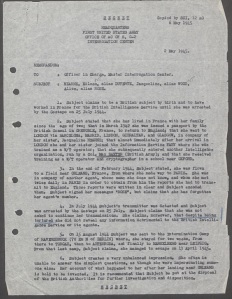 buried with her – but we are not told what eventually became of them. The currency was no doubt discarded, and ‘documents relating to the war’ were was claimed by MI5.
buried with her – but we are not told what eventually became of them. The currency was no doubt discarded, and ‘documents relating to the war’ were was claimed by MI5.
This leaves the fascinating question about the nature of the French correspondence. What could those letters have been about? Who was the other correspondent? Did MI5 take them as well? It has been claimed that some of the information regarding Nearne’s wartime experience is still classified.
It is likely that there may have been many heterosexual women who were war heroes, who never married and lived in lonely seclusion with no friends or family, but in my personal (and I admit, possibly biased) calculus, Eileen Nearne was probably a lesbian, and if she wasn’t, she may as well have been.
There are many considerations that lead to this conclusion, based in large part on Nearne’s reclusiveness. If she was indeed a lesbian, she would have had several compelling reasons to remain incognito, the most significant to me being that the British Government did not prove to be particularly grateful for even the most exceptional services rendered to them by its non-heterosexual and non-male citizens.
The harassment suffered by Alan Turing, (the man who cracked the Enigma Code,) which culminated in his suspicious ‘suicide’ – or probably murder – is a testament to the fact that the British Government did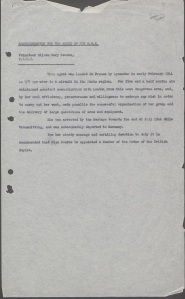 not feel obliged to honour the service and sacrifice of its gay subjects, even if their service was critical in winning the war. It did not matter to the British government that the war would certainly have been prolonged, if not lost, without Turing’s code-cracking genius. He was charged and convicted of gross indecency for a private consensual homosexual act, and subsequently forced to take synthetic estrogen for the period of one year. His mysterious death by ingestion or inhalation of cyanide about a year after he had served his ‘sentence’, when he was said to be in good spirits, suggests that he was murdered by his former employers in the British Secret Service, who after the war was over, may have concluded he was disposable.
not feel obliged to honour the service and sacrifice of its gay subjects, even if their service was critical in winning the war. It did not matter to the British government that the war would certainly have been prolonged, if not lost, without Turing’s code-cracking genius. He was charged and convicted of gross indecency for a private consensual homosexual act, and subsequently forced to take synthetic estrogen for the period of one year. His mysterious death by ingestion or inhalation of cyanide about a year after he had served his ‘sentence’, when he was said to be in good spirits, suggests that he was murdered by his former employers in the British Secret Service, who after the war was over, may have concluded he was disposable.
Nearne’s habit of enforced secrecy – vitally essential to her wartime survival – may have been a hard one to break. But she may have wisely decided that as a lesbian, her post-war survival and possibly her pension, might have depended on her continuing to keep below the radar. Secrecy might indeed have become a life-and-death imperative, for her, not only in war-time, but afterwards, for a this different reason. It may have been impossible for her to overcome what might have grown to be a pathological reticence.
What was considered criminal and what was not, in those days, as now, was fairly arbitrary. During and after WW2, the British committed many shameful acts in order to protect members of the aristocracy who were enthusiastically pro-Nazi. One should not forget that Edward VII and his wife Wallis Warfield were keen admirers of Hitler. British wartime Nazi sympathizers included Admiral Sir Barry Domvile, head of the the British naval intelligence, who was a friend of Goebbels and Himmler. Domvile, who was in favor of an alliance with Germany, was detained by the British government at the beginning of the war, but many others remained in power, and retained their positions of influence, and were never disciplined either for their actions or for their views.
 This pro-Nazism may not have seemed criminal in those days, but lesbianism, while not explicitly criminalized, received the treatment more suitable to criminal activity. Given the atmosphere of intense homosexual repression in that time, Nearne might have come to the conclusion that secrecy was the price she had to pay for her survival.
This pro-Nazism may not have seemed criminal in those days, but lesbianism, while not explicitly criminalized, received the treatment more suitable to criminal activity. Given the atmosphere of intense homosexual repression in that time, Nearne might have come to the conclusion that secrecy was the price she had to pay for her survival.
One can get a very vivid impression of this era from lesbian pulps of the ‘Fifties – conditions that are almost impossible to imagine for those who have not lived through them: Being gay was considered evil, sinful, pathological and criminal. Any intelligent lesbian might well have felt that God, the state, the medical/psychological establishment, society and family together were colluding to extinguish her life.
While it is true that the gallant example offered by Nearne’s older siblings alone might have been sufficient inducement to her to join the S.O.E, if Nearne was a lesbian, this might have been all the more reason that she was receptive to the S.O.E.’s recruitment efforts. She probably decided that the only useful thing to do with her life (if other ‘normal’ and ‘human’ choices were denied her), would have been to throw caution and all else to the winds and risk everything in order to find a niche and a purpose in life, regardless of the dangers involved.
But the Ravensbrück experience may have depleted her of whatever emotional strength she had left at the end of her ordeal. While living with her sister Jacqueline, Nearne is said to have painted violent pictures in an effort to exorcise her horrific wartime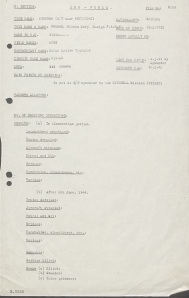 experiences at the hands of the Germans. She must have yearned desperately for peace; hence the quiet – almost silent – remainder of her life.
experiences at the hands of the Germans. She must have yearned desperately for peace; hence the quiet – almost silent – remainder of her life.
Nearne was grossly underestimated by her S.O.E recruiters, and her character, and abilities were described by them in vividly derisive terms, as shown in the document at the top of this page. One wonders now how these recruiters, whose reports of Nearne were so cruelly scathing – and so wrong – might themselves have fared if subjected to the tortures Nearne suffered at the hands of the Gestapo and the S.S. Nearne, after all, was a woman who received distinguished awards for her “cool efficiency, perseverance and willingness to undergo any risk.”
When the news about Nearn’s death made its way into the media, and it was made public that what lay in store for her body was either a cremation or what was known as a council funeral (in other words a pauper’s grave), Torquay citizens were indignant and outraged. Offers of money to cover the cost of a funeral service and a decent burial for Nearne poured in. A local funeral service offered to defray the expenses for the obsequies.
The government, however, made no such offers, though the British Royal Legion (or the Royal British Legion, the Daily Mail article from which I gleaned my first bits of information has it both ways) magnanimously offered – rather than a genuine acknowledgment of of services – to to place a flag on her coffin, which might have been in any case the minimum required gesture owed to someone who served her country. The funeral was scheduled to be held on September 21st, three weeks after Nearne’s death.
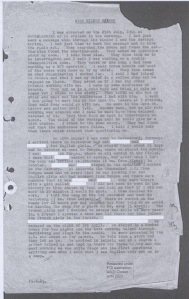 Nearne’s neighbors had no idea whatsoever about her spectacular wartime record. They had not the slightest notion that they were living next to a war hero.
Nearne’s neighbors had no idea whatsoever about her spectacular wartime record. They had not the slightest notion that they were living next to a war hero.
The Daily Mail quoted Nearne’s neighbor Steven Cook as saying “She was very reclusive: I was very surprised at the extent of her heroism. You would never have thought it, as she never spoke of it. I just want everyone to know what she had done in her past.”
An unnamed neighbor describes Nearne as being a contributor to animal charities, who sat outside her flat with her ginger cat, and read the newspaper. The neighbor states that Nearne never talked about herself but only about the cat! I am sure she would have wanted a good home to be have been found for the animal, but I have not been able to find any mention of him.
Another interviewee, Jane Roberts of Oxford, made the poignant statement “How sad, and how dreadful that a woman who served her country with such courage should have died alone.”
An article in the New York Times states:
Friends said that she withdrew into herself and shunned all opportunities to earn celebrity from her wartime experiences. In 1993, she returned to Ravensbruck for a visit, but otherwise she cherished her anonymity. As she told a television
interviewer several years before she died: “It was a life in the shadows, but I was suited for it. I could be hard and secret. I could be lonely. I could be independent. But I wasn’t bored. I liked the work. After the war, I missed it.”
The Daily Mail article, which was the first to report Nearne’s death, was probably written by an inexperienced stringer, who nevertheless seems to have done a very creditable job. However, it contained several statements that simply did not add up.
The article stated that:
The funeral director has offered to not only pay for the service but to move it to a larger church to accommodate the members of the public who wish to attend.
…The lack of any next of kin means that Torbay council will now pay for the funeral next week.
The Torbay council had been contacted by various organizations offering to pay the funeral expenses.
The public was informed that their donations were no longer needed.
We (the Torquay Council) are liaising with the Royal British Legion regarding a protocol for the service so Ms Nearne can be laid to rest with the dignity and respect she deserves.
The daring British Second World War spy who died alone in her flat earlier this moth will receive an all-expenses paid funeral following public outcry that she was to be cremated unmourned.
(…A spokesman) added that the funeral will be arranged by the authority (MI5) who will claim the money back from her estate.
The original funeral was due to be held on September 21st but a new date will now be found.
The funeral service will be held at Drake’s Chapel in Hele Road, Torquay, on September 21st at 11 am.
But finally The Torbay & District Funeral Service of Torquay footed the bill for Nearne’s funeral, which was held as scheduled on September 21st 2010 at Our Lady Help of Christians and St Denis Roman Catholic Church, Torquay.
In accordance with her wishes, (apparently made known by Nearne to a niece who lived in Italy) Nearne was cremated rather than buried, and her ashes were scattered at sea.
